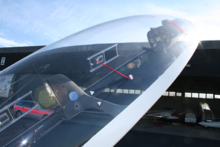Thread (glider)

In gliding, a thread or canopy thread is a short, mostly red wool thread that is usually attached to the outside of the cockpit canopy of the glider and is visible from the inside on one side. Even in modern high-performance sailplanes, the thread is a cheap but important tool.
Hood thread
In flight, the thread aligns itself like a flag along the airstream and shows the pilot the direction of the air flow on the aircraft. In order to fly with as little resistance as possible, you steer in such a way that the thread remains parallel to the longitudinal axis of the aircraft. If the aircraft does not move along its longitudinal axis, but rather laterally “obliquely” through the surrounding air, the air resistance increases , the aircraft unnecessarily loses speed and / or sinks. This condition is known as "sliding flight".
The spherical vial performs a similar task in powered flight, but the thread on gliders is much more sensitive. Due to the curvature of the hood, the deflection of the thread is greater than the sliding angle, making it easier to read.
The thread can also be found on aircraft such as the Lockheed U-2 .
Side thread
A less common use of the thread is as a side thread : two threads to the left and right of the instrument panel attached to the outside of the hood to show the angle of attack . With the help of the thread, the glider can, depending on the situation, be flown with the angle of attack of the best glide, the least sink, and safely with an angle of attack below the stall. Without a sideline, the pilot tries to fly at these angles of attack using the airspeed indicator. The side thread, unlike the airspeed indicator, shows the angle of attack regardless of the load, water ballast, load factor and cable pull in the winch start .
To read off the side thread, markings are made on the hood (or on transparent adhesive tape) showing the positions at stall, at the slightest sink and at the best glide. As with the hood thread, the movements of the side thread are greater than the changes in the angle of attack, which makes it easier to interpret. Of course, side threads and hood thread can be used at the same time. Since the side thread is very sensitive to the sliding angle, it is recommended to attach side threads on both sides of the hood.
Extensive investigations of the sideline were carried out and published by the Cologne Academic Aviation Group .
Individual evidence
- ↑ Winfried Kassera: Flight without a motor . 19th edition. Motorbuch-Verlag, 2009, ISBN 978-3-613-03069-5 , Technik des Fliegens, p. 102 .
- ↑ DG Flugzeugbau: Everything depends on the side thread
- ↑ Prof. Dr.-Ing B. Schieck, News about the winch start and about the sideline ( memento of the original from June 11, 2015 in the Internet Archive ) Info: The archive link was inserted automatically and has not yet been checked. Please check the original and archive link according to the instructions and then remove this notice.
- ↑ Piontkowski, Everything is hanging on the sideline ( memento of the original from June 11, 2015 in the Internet Archive ) Info: The archive link was inserted automatically and has not yet been checked. Please check the original and archive link according to the instructions and then remove this notice.
- ↑ Akaflieg Cologne, Everything depends on the thread, new version
